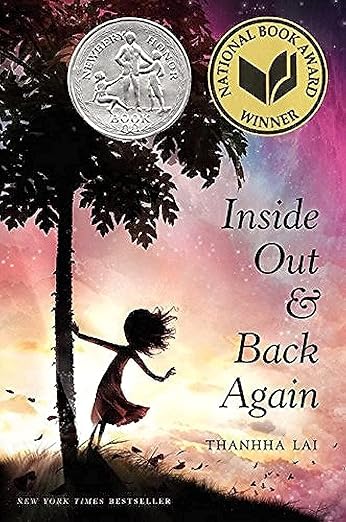When the world turns upside down, can one girl, through courage and resilience find her way home?
Thanhha Lai’s Inside Out & Back Again is a verse novel for ages 9–12 that chronicles ten-year-old Hà’s escape from Saigon during the 1975 fall of South Vietnam and her family’s resettlement in Alabama. Through fragmented yet vivid poems, Lai captures Hà’s grief over leaving home—her papaya tree, her father’s absence—and her struggles to adapt to a foreign culture. The narrative balances raw vulnerability with moments of levity, such as Hà bargaining with the “rice cooker god” or defiantly growing scallions in an Alabama winter. Key historical details, like the ethical weight of burning personal documents to evade communist soldiers, are conveyed through sensory immediacy rather than exposition, making complex geopolitics accessible to young readers.
Educators will appreciate how the text immerses students in Vietnamese traditions, from Tet celebrations with bánh chưng rice cakes to the ritual of naewoebŏp (ceremonial bowing to elders). Lai weaves cultural specifics—like the significance of quốc ngữ, Vietnam’s Latin-based script—into Hà’s daily life, offering natural entry points for discussing language preservation and diaspora identity. For students with refugee backgrounds, Hà’s experiences of mockery over mispronounced words (“MiSSS SScott”) or confusion at American customs (Halloween, peanut butter) validate their own navigation of cultural duality. The book also contextualizes the human cost of war, such as Hà’s mother quietly mourning her husband’s disappearance, fostering empathy for intergenerational trauma. These themes align with curricula on global conflicts, oral histories, and cross-cultural communication.
Lai, a Vietnamese refugee who resettled in Alabama as a child, draws from her lived experience to craft Hà’s voice with unflinching authenticity. The novel, written in English, won the 2011 National Book Award for Young People’s Literature and a Newbery Honor for its lyrical yet accessible style. Its verse structure—terse, image-driven lines—models creative writing techniques while accommodating reluctant readers. For classrooms exploring migration or equity, the story bridges 1970s refugee policies to modern debates about belonging, inviting parallels to contemporary displaced communities. By centering a child’s perspective on loss and resilience, Lai offers a timeless tool for fostering cultural humility and critical conversations about identity in an interconnected world.

